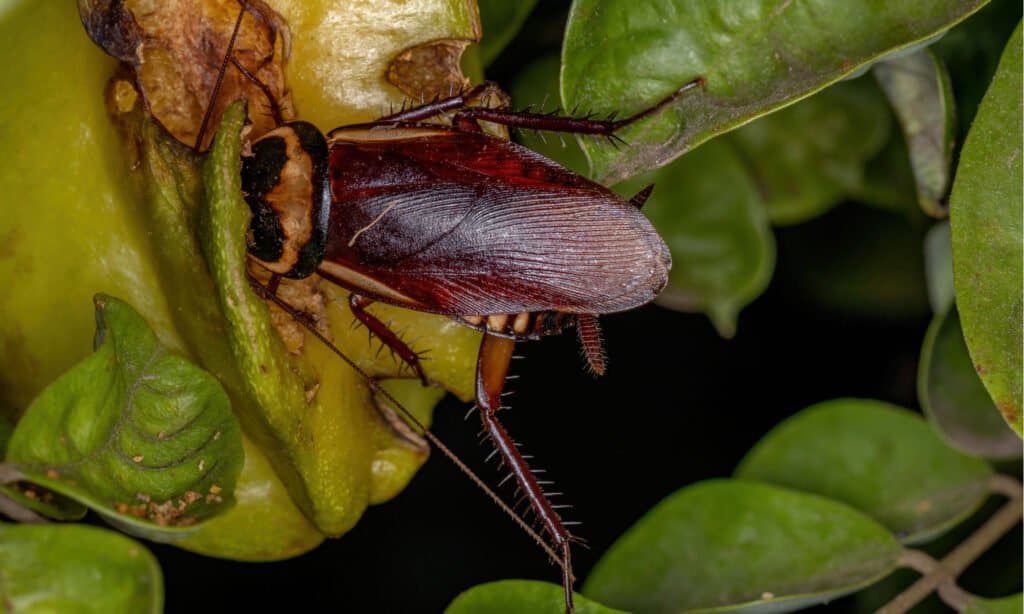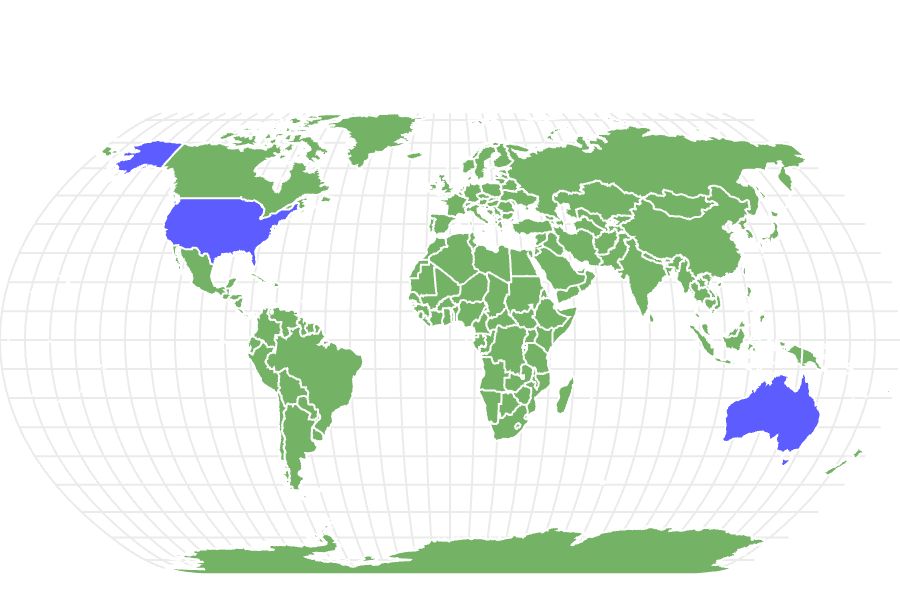Australian Cockroach
Periplaneta australasiae
The most common type outdoor roach in Florida
Advertisement
Australian Cockroach Scientific Classification
- Kingdom
- Animalia
- Phylum
- Arthropoda
- Class
- Insecta
- Order
- Blattodea
- Family
- Blattidea
- Genus
- Periplaneta
- Scientific Name
- Periplaneta australasiae
Read our Complete Guide to Classification of Animals.
Australian Cockroach Conservation Status
Australian Cockroach Facts
- Prey
- Decaying plant matter
- Name Of Young
- Nymph
- Group Behavior
- Colony
- Fun Fact
- The most common type outdoor roach in Florida
- Biggest Threat
- Extermination by humans
- Most Distinctive Feature
- Tan head with dark brown markings
- Other Name(s)
- Waterbug, shad roach
- Gestation Period
- 40 days
- Litter Size
- 12-24 eggs per egg case
- Diet
- Omnivore
- Type
- Insect
- Common Name
- Roach
- Number Of Species
- 1
- Location
- Africa, Australia, North America
- Group
- Cockroach
View all of the Australian Cockroach images!
“Despite their name, Australian cockroaches are thought to have originated in Africa.”
Out of all the cockroach species in the world, the Australian roach just may be one of the prettiest—for a cockroach, that is. Australian cockroaches are also called waterbugs or shad roaches; they’re one of the most common outdoor roach species in the southern United States. They may be called Australian cockroaches, but scientists actually think they originally came from Africa via ships. Today, they’ve colonized the warmer parts of North America, as well as their native Africa, and even Australia.
Australian cockroaches are just one of the thousands of roach species around the world. In fact, despite the fact that they like to hang out around man-made dwellings, they’re one of the less problematic cockroach species. Other roaches, like the American and German cockroaches, live entirely indoors and infest homes. The Australian cockroach, on the other hand, actually prefers the outdoors, and only comes inside in cases of cold weather, or in search of food.
4 Incredible Australian Cockroach Facts!
- Australian cockroaches are adept flyers
- Nymphs have no wings
- Males and females are almost indistinguishable from one another
- They can live up to 18 months
Australian Cockroach Species, Types, and Scientific Name
The Australian cockroach’s scientific name is Periplaneta australasiae. This species of roach is most often confused with the American cockroach, which is very similar in appearance. Interestingly, though Australian roaches aren’t actually from Australia, they’ve actually become one of the lucky country’s invasive cockroach species. It’s no wonder they’ve colonized Australia, Africa, and the warmer parts of North America—Australian cockroaches love heat and humidity.
Appearance: How to Identify Australian Cockroaches
Australian cockroaches look very similar to other species of problem roach, like the American cockroach. All cockroaches have six legs, two antennae, and bodies separated into segments. The basic cockroach form hasn’t changed much in the last 300 million years; ancient cockroach fossils look almost identical to today’s roaches.
The adult Australian roach has little sexual dimorphism, meaning males and females look almost exactly alike. Both are a rich, mahogany color, with yellow heads marked by two squarish brown markings. Their bodies are divided into the head, thorax, and abdomen. The head is covered by a hard, shield-like structure called a pronotum; this is the yellow and brown part of the body.
Beyond the head, the Australian cockroach’s wings cover the thorax and abdomen. Their wings are actually longer than their bodies, giving them the ability to achieve true flight. Below the wings are six legs—one pair attached to the thorax, and two pairs attached to the abdomen. Like most species of cockroach, the Australian roach has stiff spikes on its legs that aid it in climbing and gripping smooth surfaces.

©Vinicius R. Souza/Shutterstock.com
Life Cycle: How to Identify Australian Cockroach Eggs
The life cycle of the Australian cockroach can be summarized in three words: egg, nymph, adult.
The egg stage lasts approximately 40 days. Eggs come encased in an egg case called an ootheca that looks like a tiny, dried kidney bean. Each ootheca has between 12-24 eggs inside; with luck, each will hatch into a baby cockroach. The mother doesn’t carry the egg case around for long though, instead, she opts to glue it in a safe place, like inside the bark of a tree, or in an out-of-the-way crevice.
On hatching, the larval roaches have no color and are only the softest of exoskeletons. They grow rapidly though, molting and regrowing their ‘skin’ five times before reaching adulthood. This process can take up to one year, depending on weather conditions. Interestingly, nymphs grow faster in the presence of other nymphs—so a lone nymph will take longer to mature than a nymph among other nymphs.
After the final molt, the nymphs become adults. For the first time in their lives, they have wings and can fly away from predators. There is a downside to adulthood for the Australian cockroach though—it only lasts 4-6 months. Adult females make the most of their short lives, producing up to 30 egg cases before they die.
Habitat: Where to Find Australian Cockroach
Like many peridomestic roaches, the Australian cockroach prefers to live outdoors, rather than in human homes. They’re not a cold-tolerant bug though and must choose areas with plenty of light, warmth, and humidity. This makes them one of the most common outdoor cockroaches in the southern United States. They’re especially prevalent in Florida, where they live among other outdoor species of roach.
Australian cockroaches make their homes near buildings, in gardens, or landscaped areas. They’re particularly fond of mulch, leaf litter, woodpiles, and manicured gardens. They’ve even been observed hanging out around exotic species of garden plants—who says cockroaches don’t like to stop and smell the flowers?
Only on rare occasions do Australian cockroaches come inside. They may head indoors in case of cold weather; they don’t tolerate the cold well, but they can go longer without water than some species of cockroach. If you find one in your home, and it’s not cold out, then it may have followed its nose. Australian cockroaches can fly into homes via open windows, doors, tiny cracks, or even plumbing fixtures like water pipes and toilets.
Diet: What do Australian Cockroaches Eat?
Australian cockroaches feed primarily on dead and decaying green waste, like dead leaves and rotting trees. Their favorite meal is a plant that has died, but that doesn’t mean they’ll turn their ‘nose’ up at any easily available snack. Like all cockroaches, Australian roaches are opportunistic omnivores who will eat anything available. This includes human and pet food, as well as mulch, plants, leaf litter, and garbage.
What Eats the Australian Cockroach?
Australian cockroaches may be able to fly, but flying isn’t all it’s cracked up to be when it comes to aerial predators. Birds, like crows and hawks, are quick to snap up Australian roaches on the wing. On the ground, they often fall prey to toads, frogs, mice, rats, snakes, and lizards.
Australian Cockroach vs American Cockroach
Because they live in many of the same environs, it’s easy to confuse Australian and American cockroaches with one another. American cockroaches are slightly bigger, growing up to two inches in length. But, both species have full-length wings and red-brown bodies. Even the markings on their pronota are almost identical.
It may seem impossible to tell the two species apart, but this cockroach has one key feature that the American cockroach lacks. These cockroaches have a tan-colored stripe on the upper outside margin of their forewing; American cockroach wings are entirely brown, with no stripe. If you’re still not sure what type of roach you’re looking at, consider where it is; if it’s inside, it’s probably an American cockroach.
Prevention and Extermination: How to Get Rid of Australian Cockroaches
These cockroaches aren’t generally considered a pest species. That being said, they can still spread disease and pathogens and trigger asthma in people, so you don’t want them inside your home. The best way to prevent Australian roaches from getting out of control around your home is to remove all unnecessary green waste, like leaf litter and dead plants. Additionally, stack firewood away from the home, and ensure that you keep screens on any open doors or windows. If you do have an Australian roach infestation, you may want to call in a professional pest exterminator. If you would rather take care of the problem on your own, you can always purchase glue or bait traps and place them outside. Take care, however; cockroach traps and insecticides are toxic to both humans and pets.
View all 194 animals that start with AThank you for reading! Have some feedback for us? Contact the AZ Animals editorial team.
Sources
- University of Florida Entomology Department, Available here: https://entnemdept.ufl.edu/creatures/urban/roaches/australian_cockroach.htm
- NC State University Extension, Available here: https://content.ces.ncsu.edu/australian-cockroach

















